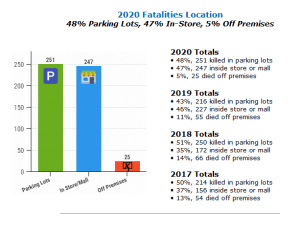Record Setting Annual Fatalities and Injuries in Retail
According to the 2020 Retail Violent Fatalities Report recently published, there were 523 fatalities in the retail settings, which was a 40% increase in cases over 2019. This is an all-time record, but will anything change? Will those numbers come down, or is this a sign of the times and the new normal?
Are Retail Environments Dangerous?

Source: The D&D Daily 2020 U.S. Retail Violent Fatalities Report
The simple answer is no, but there really is no such thing as a simple answer to such a complicated situation that we are experiencing. According to The D&D Daily, based out of northeastern Ohio, there were 485 fatal retail incidents in 2020, and they resulted in 523 deaths across the country. Of those deaths, 256 of them were customers, 128 were the suspects, 123 were employees, and 16 law enforcement/security officers.
It was also reported that even with the shutdowns related to the ongoing pandemic, the number of incidents increased. Some of the main causes were the civil unrest that spread across the country in 2020, as well as the high number of unemployment levels, business failures, and a number of other factors. I think it is safe to also include the polarizing divide throughout the country that was being fueled by the political posturing that was rampant in 2020. We could debate all day long as to the root causes, and point fingers in all directions, but why was it happening mostly in retail settings? Also, why did the retain industry not see this coming early on and plan and prepare for it?
Security vs. Loss Prevention
The questions that often comes up is why do retail stores not increase security? They must know that deaths are occurring in their industry that are related to a number of violent crimes that are occurring, right? Well, you might think that that is a no brainer and that they know of the trend and risks, yet there are no signs of meaningful increases in security for the most part.
Retail stores have historically spent their money on measures to deal with the loss from shrinkage. Basically speaking, they are trying to prevent shoplifting. For the most part, they spend money on security cameras and electronic tagging of high value items, but do these measures reduce the number of losses?
In some cases, some of the larger retailers have resorted to hiring off-duty police officers to be in the stores walking around in an attempt to be a deterrence to shoplifters. In some cases, they will have them sit inside their cars near the front of the stores in order to be a deterrence for purse snatchers or car break-ins, but do these measures work? It really depends on who you ask as to how any of those questions will be answered.
Several years ago, I was retained as an expert witness in a case involving a violent and life-threatening incident that occurred in a parking lot of a major retailer. Part of my job was to review all policies, security operations, and the security videos to ascertain what happened and if it could have been prevented. What was discovered was that there were no policies, other than loss prevention policies, and the main focus of their loss prevention program was with respect to the loss of their inventory, not security.


Source: The D&D Daily 2020 U.S. Retail Violent Fatalities Report
In this case had someone been observing the parking lots prior to this incident, either on foot patrols or even watching the security cameras, they would have noticed some very suspicious activities. There would have been no doubt that something was about to happen, and they could have called the police in an effort to be pro-active. Yet no call was made, and no one took any actions at all to deal with anything that was occurring in the parking lot. The reality was that they were likely focused on preventing a minor property crime (Shoplifting) to protect their inventory, and likely had no clue as to a violent attack in their parking lot. I will leave it to you to decide if their priorities were misplaced. However, the facts tell us that 48% of those killed in the retail settings occur in their parking lots, and of the deaths, 50% were in convenience stores or restaurants.
I do not think any reasonable person can argue that the statistics tell us where we need to reassess our focus and mitigation steps, and that the response to such a risk has to be one that is reasonable. We need to focus on the risks and vulnerabilities related to our employees and customers and take appropriate measures to prevent crimes from occurring in the first place. In other words, we are in many cases allowing the shoplifting to occur, as we are often watching it real-time in progress either in person or via security cameras, and then we are making the detention at the exit doors or slightly past them. At this point we are at a disadvantage, and the person is often times outside the building, and they will run if given the chance. To them it is the Fight or Flight scenario where they will make a snap decision.
Misdemeanor vs. Felony
Shoplifting in most cases are misdemeanors, basically a minor crime. In most states it may not even result in jail time and is often a cite (ticket) and release on the spot. As you might already know, in California a person could shoplift almost a $1,000 worth of inventory before they are arrested. This has caused numerous retailers to close shop or hire armed security to protect the store.
There are other states that have laws on the books that say that if a shoplifter physically injures an employee that is trying to apprehend them for shoplifting, that person (suspect) can be charged with robbery. So, in those cases, one could argue that they feared for their (suspect’s) life, so they fought off their attackers (staff) and they ran. Thus, they committed a minor crime that elevated into a felony crime, but they claim self-defense. There will also be those suspects that have previous felony charges, and they have nothing to lose so they will be the aggressor, many of these cases may have resulted in the 139 fatalities in 2020 of law enforcement/security, and staff deaths.
Retailers Response to Increased Numbers of Fatal Attacks
Again, we need to focus on prevention, and in my opinion that means that we need to find ways to deter criminal incidents from occurring, not watching for someone to steal and then cross the exit door threshold so we can detain them. When someone says we have loss prevention in place, and they actually have loss prevention agents that are watching from a distance or via video, just how is that “preventing” losses? Stores that diligently greet customers as they walk in, and who staff that are walking up to customers in a friendly manner and asking if they need assistance, are actually preventing losses.
Studies have shown us that in those retail stores that greet every customer when they come in, or even when they start to pump gas outside, they are in reality putting those customers on notice that they have been seen. Those often-perceived pesky employees that continuously ask if you need assistance, are also in fact preventing losses, because those would-be shoplifters know that they are being observed in person, and as a result the risks of losses will be reduced.
Security technology has its purpose and there is little doubt that it can be beneficial to the retailers. Placing Radio Frequency Identification (RFID) tags on high-value, or often stolen items, will also help, if it is used properly. By that I am referring to the numerous stores that do not maintain the equipment properly, or do not take alarms at the exit doors seriously.
Security cameras have become so common in every aspect of our culture, that for the most part people do not even know they are being videoed. As far as a deterrence, they may in fact be just that to small time thieves, but one only needs to watch the daily news or go online to see the thousands of videos of crimes in progress that did not deter the offenders. Keep in mind to that banks have been using security video cameras for decades and yet the banks continue to get robbed and the suspect is often not wearing a disguise.
The main point here is that retailers cannot claim plausible deniability when it comes to the risks of a fatal incident occurring on their property. The crime statistics as stated within this article are freely available to the general public and are also available through their (retail) associations. Those retailers that are installing bullet-resistant glass to protect their employees or hiring security/police officers to be on their property are acknowledging the risks are present. Yet even with all that, there are still plenty of retailers that will claim they did not know.
I will leave you with this, if you think that your employees and/or customers are not at risk I certainly hope that you have the facts to support that. If you are not certain as to what your risks are, you need to find out now before a serious incident occurs. The money spent on a professional and independent security expert is an investment for the long term. It can also be your assurance that your risks are not only defined, but also assigned the proper mitigation steps, so as to keep you out of a civil litigation case. Although the thought of saving money on retaining an “expert” may be enticing when you hire a security vendor that sells security technology or guard services, what is almost certain to happen is that they will try to sell you some technology or guard services. So if a firm offers to conduct a security risk assessment for free, remember that nothing is for free.





